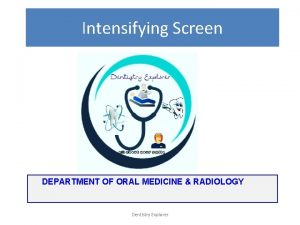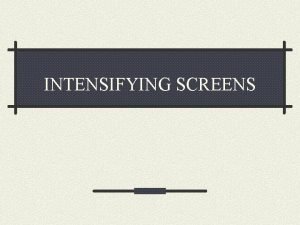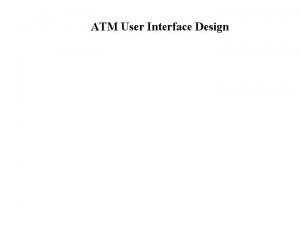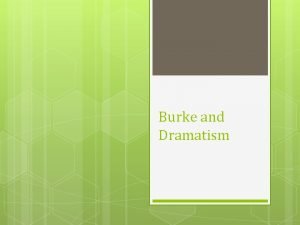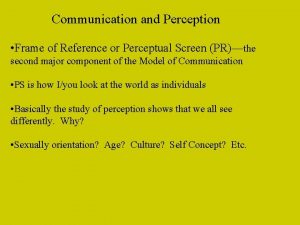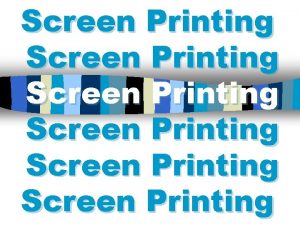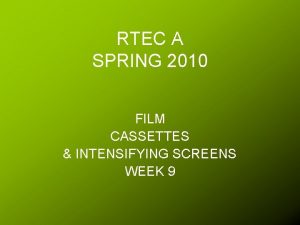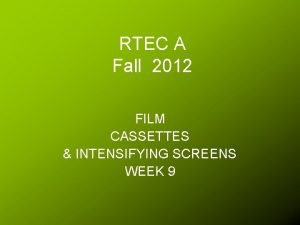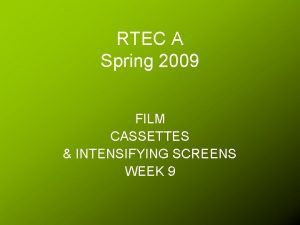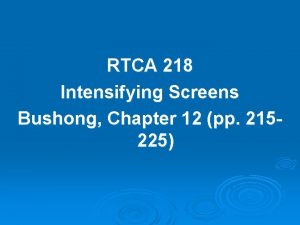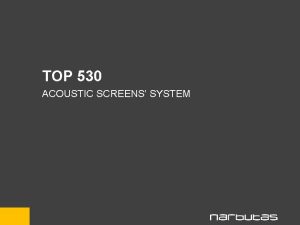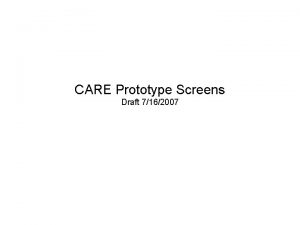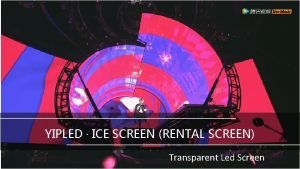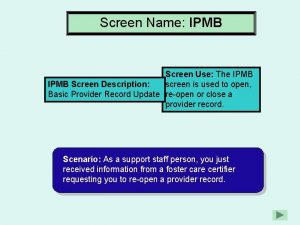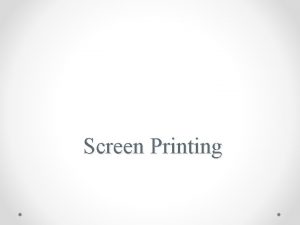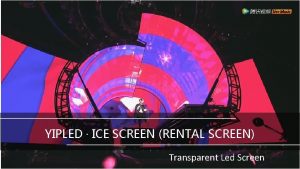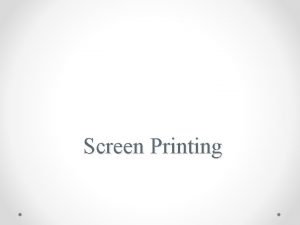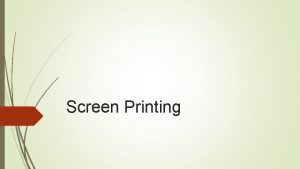INTENSIFYING SCREENS INTENSIFYING SCREEN is a device that




















- Slides: 20

INTENSIFYING SCREENS

INTENSIFYING SCREEN is a device that converts X-rays to visible light. It converts a higher energy electromagnetic radiation to a lower energy electromagnetic radiation. In general, films that are exposed using screens has an image that is produced 95% by light and 5% by X-rays.

INTENSIFYING SCREEN ADVANTAGES OF USING SCREENS n n n reduces the dose required for a particular examination. short exposure time less movement unsharpness DISADVANTAGE OF USING SCREEN n introduces the screen unsharpness

INTENSIFYING SCREEN

CONSTRUCTION OF SCREENS

CONSTRUCTION OF SCREENS BASE n n n This acts as a support for all other layers of intensifying screen. Made of polyester. 250 microns ( ) thick for cassettes and 175 for screens used for automatic film changers.

CONSTRUCTION OF SCREENS REFLECTIVE OR ABSORPTIVE LAYER n n modern technology has already incorporated the reflective or absorptive layer in the upper part of the base. Reflective layer intercepts light going away from the film and redirects it towards the film. n n n Increases speed but increases also the amount of unsharpness. Made from thin (30 ) coating of titanium dioxide (Ti. O 2) or similar compound. Absorptive layer absorbed the light travelling away from the film. n n This layer is made of dye incorporated on the base material. This slows down the speed of the system, but has the advantage of improving the sharpness of the image.

CONSTRUCTION OF SCREENS SUBSTRATUM n n Attach the phosphor layer to the base. This should be as thin as possible but should provide adequate adhesion. PHOSPHOR LAYER n n This is a dispersion of the phosphor crystals within a suitable binder. It is approximately 150 .

CONSTRUCTION OF SCREENS n Binder material that is commonly used by manufacturer is the acetate acrylate as this has all the necessary characteristic: n n n Flexible Inert to phosphor crystal and the light they emit Provide even, known dispersion of the phosphor in the binder Allows the phosphor layer to be coated onto the base at the required thickness. Phosphor crystal is a metallic crystalline solid, naturally occurring or artificially made, that exhibits the property of fluorescence when exposed to X-rays and can be manufactured in useful form to produce high image quality. n n Calcium tungstate (Ca. WO 4) Rare earths

CONSTRUCTION OF SCREENS SUPERCOAT n n This is the top protective layer of the screen. It is approximately 8 thick. It is made of cellulose acetobiturate, or other polymer. It serves three functions: n n n protects the delicate phosphor layer from mechanical damage, provides a surface which can be cleaned without damaging the phosphor layer, and provides a smooth evacuation of entrapped air resulting in a good film-screen contact. It must be a poor conductor of static electricity. The surface of protective coating can be made with varying “roughness”.

INTENSIFYING ACTIONS OF SCREENS CONVERSION EFFICIENCY OF PHOSPHOR n The efficiency with which the phosphor converts Xrays to light. Efficiency = absorption x conversion x emission

INTENSIFYING ACTIONS OF SCREENS SCREEN EFFICIENCY n The ability of the intensifying screen to absorb X-rays, to converts it to light, and to allow the light to escape from the screen and expose the film. Exposure required to produce ND 1. 0: No screens IF = ----------------------------------Exposure required. FACTOR to produce ND 1. 0: With INTENSIFICATION screens n It is the ratio of the x-ray exposure needed to produce the same density on a film with and without the screen.

SCREEN SPEED AND DETAIL The relationship between screen speed and detail is a reciprocal one: as the speed of the screen increases, the amount of detail decreases. FACTORS AFFECTING SPEED n n n n Phosphor type Phosphor grain size Thickness of phosphor layer Coating weight Presence of reflective/absorptive layer Dye tint in binder Exposure technique

SCREEN DETAIL SCREEN UNSHARPNESS n Due to divergent emission of light coming from intensifying screen. CROSSOVER EFFECT n It is a result of the widening light beam emitted by the crystal as it passes from one emulsion to the other, causing a shadowy, less sharp image in the emulsion layer furthest from the intensifying screen.

SCREEN DETAIL STRUCTURE MOTTLE n It is caused by the fact that it is not possible to evenly dispersed the phosphor crystal throughout the binder medium. SCREEN-FILM CONTACT n Poor film-screen contact , causes the light emitted by the intensifying screen to diffuse before it reaches the film, so that the image produce is unsharp.

TYPES OF PHOSPHORS CALCIUM TUNGSTATE (Ca. WO 4) n n It is a naturally occurring phosphor and produces a continuous spectrum principally in the blue part of visible spectrum, with a peak output at approximately 425 nm. Discovered by Thomas Edison.

TYPES OF PHOSPHORS Spectral sensitivity of blue sensitive film and spectral emission of Ca. WO 4

TYPES OF PHOSPHORS RARE EARTHS n n Are soft, malleable metals that can be made to emit light upon stimulation by X-rays. First introduced in 1970’s by Wickersheim, Alves, and Buchanan. RARE EARTH SCREENS: principal phosphors, symbols, emission

TYPES OF PHOSPHORS Spectral sensitivity of green sensitive film and spectral emission of Gd 2 O 2 S. Tb

THANK YOU
 Dental intensifying screen
Dental intensifying screen Intensifying screen construction
Intensifying screen construction Input output storage devices
Input output storage devices Screen small screen offscreen
Screen small screen offscreen Gây tê cơ vuông thắt lưng
Gây tê cơ vuông thắt lưng Block nhĩ thất độ 3
Block nhĩ thất độ 3 Tìm vết của đường thẳng
Tìm vết của đường thẳng Sau thất bại ở hồ điển triệt
Sau thất bại ở hồ điển triệt Thể thơ truyền thống
Thể thơ truyền thống Hãy nói thật ít để làm được nhiều
Hãy nói thật ít để làm được nhiều Thơ thất ngôn tứ tuyệt đường luật
Thơ thất ngôn tứ tuyệt đường luật Tôn thất thuyết là ai
Tôn thất thuyết là ai Phân độ lown
Phân độ lown Walmart thất bại ở nhật
Walmart thất bại ở nhật Atm user interface design
Atm user interface design Revolving screens
Revolving screens Permatron cottonwood screens
Permatron cottonwood screens Terministic screens
Terministic screens Serp.doe.louisiana login
Serp.doe.louisiana login Vm1650 centrifuge basket
Vm1650 centrifuge basket Perceptual screens examples
Perceptual screens examples
